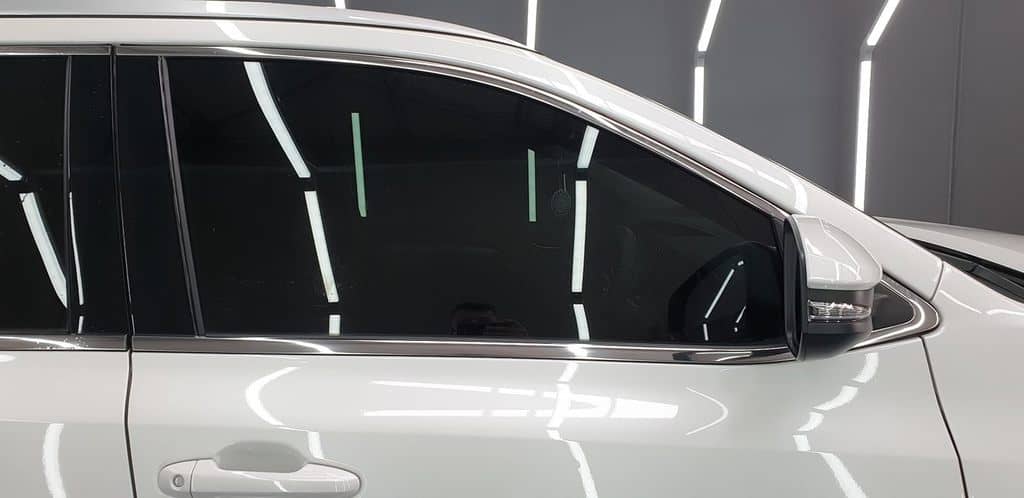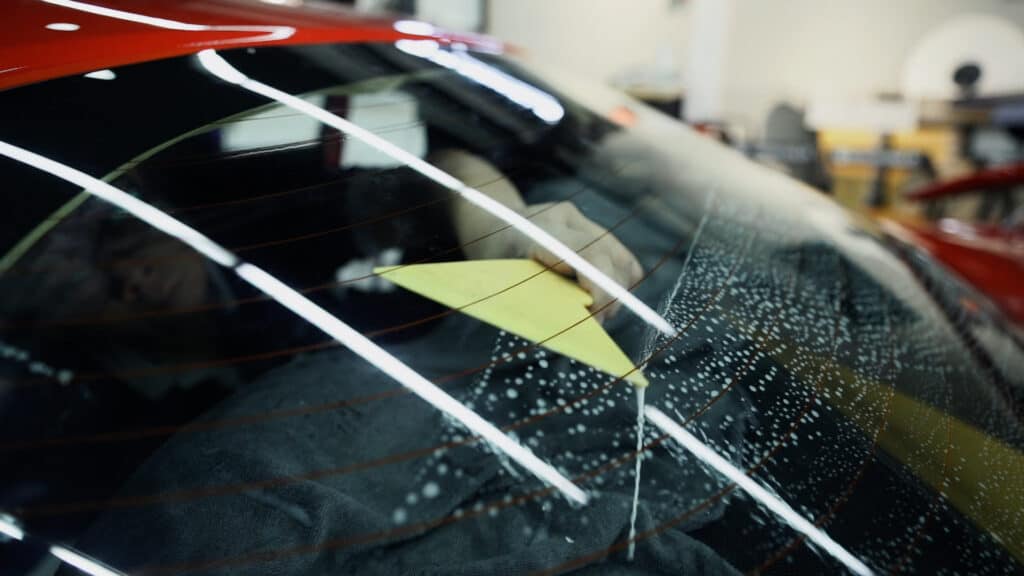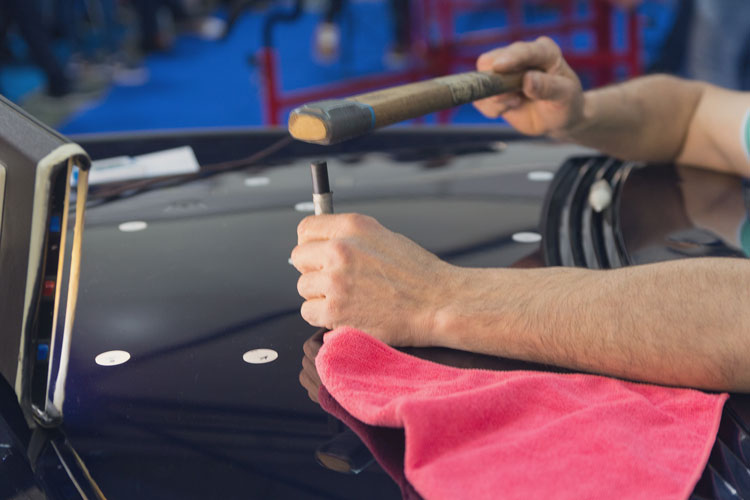Has summer heat left you sweating bullets while behind the wheel? Does “road glare” cause you to wince every time the sun deflects off a smooth surface? Is your skin burning while inside your automobile, causing you to wonder: “Do car windows actually repel UV rays?”
If you are afflicted by any, or all of these things, then it might be time to consider installing some window film on your vehicle, and word on the street is that the ceramic stuff is the way to go.
But is this cutting-edge, window protection product worth its additional asking price? How does it stack-up when compared to traditional window tint? And are there any downsides to opting for ceramic window film? These are all common questions voiced by those seeking protection from heat and sun exposure, and for just cause.
It seems that the more we learn about the risks associated with the glaring gaze of our solar system’s star, the more apparent it becomes that as humans, we must protect our tender epidermis.
The days of slinking around, looking shady as shit because limo tint was the best that the market had to offer are officially over folks. Protective automotive window films are here to stay, and as you shall soon discover, the new stuff has a metric motherload of amenities to offer.
Table of Contents
- The Early Days of Window Tint
- America Flexes Its Massive Window Film Muscles… And Farts
- The Advent of Ceramic Infused Window Film
- What Makes Ceramic Window Film Work?
- What’s the difference between regular window tint, ceramic window tint, and nano ceramic window tint?
- Solar Energy, UV Rays, and Glare Rejection
- Parting Shots, and the Future of Window Film Nano-technology
The Early Days of Window Tint

As of now the jury is till out regarding the protective properties associated with orange window film.
Photo Credit: Micah Wright
While various forms of dyed window glaze and glass coating have existed since the tail-end of World War II, early attempts at producing these products often ended in failure. These first stabs at creating “solar control” window films typically involved relying upon a dyed tint with two layers. One of these layers came packed with dark pigment for shielding occupants from sunlight, whereas the other provided an adhesive backing for attaching to the glass.
But these initial stabs at light diffusion and temp reduction tended to fail prematurely across the board, with many of these glass films “purpling” over time due to sunlight-influenced chemical reactions. There were also rampant reports of window films cracking, bubbling, and peeling, either under their own free will, or via outside influence. Due to these quality issues, early window films were often labeled as little more than automotive glass “snake oil,” and therefore failed to gather traction in the mainstream. Simply put, people weren’t tinting their windows back in the day not because window films were unavailable, but because they were complete crap.
“Viewed in its simplest form, window tint is little more than a specialized polyester film, that when applied to glass and then exposed to heat, transforms the clear glass into a transparent “smoked” surface area. Installing automotive window tint is like giving your car a nice pair of sunglasses. And like any decent pair of shades, this dark tint is supposed to not only make you look cool, but stay cool as well, all while keeping things like sunlight glare and UV rays at bay.”
AVALONKING
America Flexes Its Massive Window Film Muscles… And Farts

The only thing greater than a massive American truck, is seeing a massive American truck pull into a drive-thru and not be able to reach the pick-up window. Photo Credit: Micah Wright
“To the naked eye, window film may look like a giant sheet of plastic, but it is in fact made up of 200 thin, transparent layers of nanotechnology material; no thicker than a piece of ordinary paper. It is usually made from a type of plastic called polyethylene terephthalate (PET) because of its ability to bind to (or embed in) a variety of surfaces. PET’s tensile strength and clarity makes it ideal for car windows.”
Yet even then, 3M’s films were not immune to creasing, bubbling, cracking, and discoloring, they just did not do so as quickly, nor as often. It was not until the advent of metallic window films in the 1990s, that things really began to improve. Concocted from a metalized coating, these films deflected heat and UV rays alike, and did not change color or bubble and crease nearly as easily after being exposed to prolonged periods of intense sunlight and heat.
“To the naked eye, window film may look like a giant sheet of plastic, but it is in fact made up of 200 thin, transparent layers of nanotechnology material; no thicker than a piece of ordinary paper. It is usually made from a type of plastic called polyethylene terephthalate (PET) because of its ability to bind to (or embed in) a variety of surfaces. PET’s tensile strength and clarity makes it ideal for car windows.”
—WINDOW TINT U.S.A.
On the downside, because they were composed of metallic minerals, these window films really fucked with any electronic devices found within a vehicle, especially when it came to transmitting an airborne signal. From radio waves and remote lock controls, to pager notifications and outgoing car phone calls, if it was electronic and airborne, chances are that tint was going to impede it in some way.
The Advent of Ceramic Infused Window Film

Well here are some interesting figures. Check out the heat temp difference between a normal limo tint (right) and a high-end ceramic window film (left).Photo Credit: Texas Tint Masters/YouTube
Ceramic window film, or non-metallic window film, is one of the more recent additions to the glass protection portfolio, and is easily one of the most expensive. But last we heard you still get what you pay for, and just by glancing over all of the glowing customer and professional installer reviews, it’s pretty obvious that there is some value to this stuff.
According to window film manufacturers and pro tint installers, these products do an outstanding job of rejecting harmful heat and UV ray related risks before they can even penetrate a vehicle’s interior. Also, because they are ceramic in nature, and are therefore a non-metallized window film, these products don’t mess with radio wave signals nor do they generate glare/reflection issues.
As the window film originator, and a driving force in nano-technology advancements, 3M played a crucial role in the pioneering of modern ceramic glass coatings, and its lineup has grown significantly in recent years. The price associated with these products, as well as their installation retains a premium too, with reports of ceramic window film installs on automobiles running anywhere from $100 to $800 on average, depending upon the size of the job.
Being that 3M is the indisputable patent holder in the window film arena, and has more R&D dollars than all of the galactic credits in Boba Fett’s bounty locker, the chemical and textile monolith continues to set the pace for the window film industry. This is primarily due to the fact that 3M has the financial clout and facilities to produce its own polyesters, adhesives, metals, and scratch-resistant coatings, making it the only manufacturer of its kind to do so. From a quality control standpoint, this allows 3M to cover every step of the production process, and then stamp a certified badge of approval on each item when it is ready to ship out.
Quick Nerd Note: Historically speaking, 3M was indeed the first company to be issued a window film patent. The year was 1966, and at the time, window film was commonly referred to as “sun control.” Unbeknownst to its originators, this relatively ineffective material would evolve into a revolutionary product that would transform the world of automotive glass for decades to come.
So what makes 3M Ceramic Series Automotive Window Film so special? And is it worth the additional upfront cost? The difference with its products, 3M says, is that its competition’s ceramic window tint film are oftentimes prone to corrosion, which causes them to change color along their edges. This malady is not only unsightly, but it can lead to deeper issues down the line, like bubbling, creasing, and other forms of deformation.
But what are consumers and window film installation pros saying about the latest and greatest automotive glass protection products from 3M? Quite a bit actually. Customer and professional reviews alike remain consistently in the 4.6 – 4.9 out of 5 star range, and from what we’ve been able to glean, the claim that 3M’s products don’t discolor or warp is entirely accurate. Drivers have also noticed that interior temps become notably lower after installing 3M’s ceramic window films, that direct sunlight no longer burns their bare skin, and that glare is significantly reduced.
What Makes Ceramic Window Film Work?
What Makes Ceramic Window Film Work?
So now that we’ve established that ceramic automotive window film appears to be living up to the hype, we turn toward the topic of what makes all of these prodigious protective powers possible. The answer lies within the same nano-tech genetic backbone that is found within a high-grade 9H-rated ceramic coating.
This microscopic silica-based concoction is so small, that not only is it invisible to the naked eye, but completely indiscernible with the run-of-the-mill microscope. Ultra tough, resistant to corrosion, both hydrophobic and anti-static, this microscopic molecular marvel has been engineered to boost both visibility and clarity, and works wonders when it comes to reinforcing vehicle glass.
Take 3M’s recently released, far more advanced version of ceramic window film, a product line that it refers to as the “Ceramic IR Series.” This ultra high-end film is marketed as having superior infrared heat reduction due to “absorptive nano-ceramic technology.” Apparently, this nano-tech infused film has the ability to provide up to 99% UV protection, which in sunscreen speak, translates to SPF 1000. Yeah, rub that on your dad bod and tell us what you think.
Broken down to its bare nuts and bolts, these nano-technology infused window films reduce the sensation of sun heat on skin. So hypothetically speaking, if one were to develop a sunblock that somehow uses this technology to provide earth’s inhabitants with an SPF 1000 solution, they could potentially change the way we view sun-related skin damage. Just imagine. A world with no more unsavory sunburns after passing out at the pool while wearing your favorite European banana hammock.
But I digress… again. SPF protection isn’t the only upside to this nono-tech boosted stuff. Not only does it not interfere with 5G or any other wireless carrier service, it does not not reflect or mirror back at you while driving, nor will it corrode, change in color, or fade. Oh, did we mention that many of these window films come with a lifetime warranty and free peanut butter cookies? Hold up, that can’t be right. Surely window film manufacturers know that a massive portion of drivers suffer from nut allergies, and that they should at least offer a chocolate chip alternative.
Quick Tip: Window tint film laws tend to vary by state, province, and in certain cases, by country. Always check local laws or ask a certified installer for advice before installing a window film, so that you know what windows can be legally tinted, as well as the grade of tint that is deemed legal.
What’s the difference between regular window tint, ceramic window tint, and nano ceramic window tint?
STANDARD Ceramic Tint vs NANO Ceramic Tint (NEW!)
“Nutty” speculations aside, there are some disclaimers that should come with this stuff. Despite their similar ceramic genetic makeup, there are some pretty significant differences in the levels of protection that a basic ceramic window provides, as opposed to its far more advanced (and expensive) nano-technology infused big brother.
For comparison’s sake, we’ll pit the 3M Ceramic IR Series against its slightly less evolved Ceramic Series sibling, as they both bear the same underlying genetic makeup and are easy to compare. Naturally, there are a wide range of other products from various brands that can be cross-referenced, but for the sake of succinctness we’ll save the head-to-head comparison tests for all of the YouTube DIY enthusiasts.
Circling back to the aforementioned 3M products, you’ll find that in order for vehicles to achieve what it calls “optimal thermal comfort,” a window film must not only deflect harmful UV rays, but hamper the sensation of sun on bare skin. To achieve this feat, the Ceramic IR Series has been engineered to reject up to 66% of total solar energy and up to 95% of infrared heat from direct sunlight.
In contrast, 3M’s regular Ceramic Series window film only rejects up to 59% of total solar energy and up to 80% of infrared heat rays. The more inexpensive version of the film also doesn’t say anything about being 5G friendly, instead, it is marketed as having the ability to allow you to “…stay connected with mobile devices, GPS or satellite radio reception without interference.”
Entry-level ceramic films from 3M also only reduce 60% of sunlight glare at best, as opposed to the IR upgrade, which delivers up to 93% glare reduction. And while the base version supposedly blocks up to 99% of UV light, its total Sun Protection Factor (SPF) tops-out at 810, whereas the IR Series can hit a full 1000 SPF without issue. On the upside, both of 3M’s ceramic window film products are backed by a limited lifetime warranty.
Regardless of what brand of product you go with, or what its marketed strengths may be, almost all window film falls into the following three categories. While there is also a carbon option on the market, this recent advancement in the window tint market is a bit of a different animal, so for the sake of clarity we’ll cover that topic in a separate blog article.
Regular Tint: A metallic film that has been dyed, designed more for privacy and looks than heat and UV rejection. Inexpensive, easy to work with, and resistant to bubbling, fading, and changing in color, this has long been the go-to window film option for the rear glass on production vehicles as well as for aftermarket tint installers.
Ceramic Window Film: A ceramic-infused infrared film that offers all of the perks of metallic tint, but without pesky radio wave interference issues. This product typically offers the same grade of protection and heat resistance across the board regardless of what shade of tint you choose. As opposed to dyed window tint, which merely darkens glass, ceramic window film does not have to be super dark to block glare and infrared light.
Nano-Technology Ceramic Window Film: This type of tint takes the standard ceramic window film, and infuses it with additional layers of nano ceramic particles to boost the product's ability to block heat and harmful UV rays. Considerably more expensive than the other window film options on the market, nano-tech ceramic films are offered in virtually any shade imaginable, with the same level of protection being present in a clear film as in a super dark limo tint.
Solar Energy, UV Rays, and Glare Rejection

When it comes to window film tint, dark doesn’t always mean impenetrable. It just means added privacy. Photo Credit: Definition Car Detailing/Facebook
Hail dent pro will Protection from the sun’s rays and glare varies according to the type of tint applied, as some tints use Visible Light Absorption (VLA%) to soak-up sun glare, while others are more of a reflective window film, and rely upon Visible Light Reflection (VLR%). Measuring these percentages means relying upon the “Visible Light Transmittance (VLT%)” scale. Here, the higher the percentage, the more light is allowed to pass through the glass.
This means that the average un-tinted car window lands in the 90% visible light range, or a 90% VLT rating, which translates to only protecting you from 10% of the sun’s rays. And while the average sheet of OEM glass may block UVB rays fairly well, outside of windshields, all of the windows in an automobile won’t do shit for blocking UVA rays.
The ideal window film is a product that can provide protection against all three light-related unpleasantries. this means reducing heat and glare from UV and infrared light, all while cutting down on light glare, may it be caused by direct sunlight or headlights at night.
Parting Shots, and the Future of Window Film Nano-technology

Ceramic window film installation is a procedure that is best left to the pros. No one likes the look of bubbles in their window tint, so cough-up the extra cash and do your tint install right the first time.
If you’ve decided that it’s time to install a ceramic window film, you’ll find that your options go well beyond what 3M has to offer. Brands like Llumar, Rayno, Geoshield, Madico, Inc., XPEL, and a slew of other manufacturers have all released their own line of nano-ceramic window films, each one claiming that their product is the best. While the jury is still out in regard to which product rules all (there literally are dozens to choose from), online reviews tend to be favorable across the board as long as you stay away from the DIY bargain bin stuff down at the local hardware store.
Regardless of which product you choose, it’s worth remembering that these window films will not provide the scratch resistance, nor the water and dust repelling properties that a quality 9H-rated ceramic coating like Armor Shield IX offers. This is why many people have opted for a two-pronged attack, installing a ceramic window film first, an then ceramic coating over it for increased protection and peace of mind.
Quick Final Nerd Note: Just because that tiny-ass print on the corner of your car window states that it repels harmful UV rays, doesn’t mean that it actually does so. According to a report by America’s Skin Cancer Foundation, while everyone worries about protecting their skin from sunburn inducing UVB rays, it’s the UVA rays that cause things like wrinkles to form. Regardless of which one you come into contact with, prolonged exposure to UV rays often leads to skin cancer in humans.
Table of Contents
- The Early Days of Window Tint
- What’s the difference between regular window tint, ceramic window tint, and nano ceramic window tint?
- America Flexes Its Massive Window Film Muscles… And Farts
- The Advent of Ceramic Infused Window Film
- What Makes Ceramic Window Film Work?
- Solar Energy, UV Rays, and Glare Rejection
- Parting Shots, and the Future of Window Film Nano-technology



